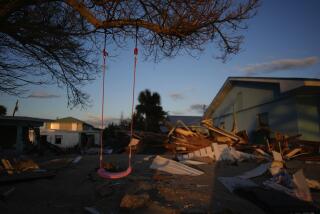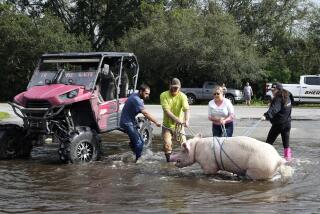Hurricane’s Stormy Tendrils Reach U.S. Coastline
- Share via
MIAMI — With millions of South Floridians hunkered down, many in boarded-up homes well-larded with emergency supplies, a relentless Hurricane Georges began lashing the U.S. coastline with high winds and squally rains late Thursday.
Already blamed for more than 200 deaths in a rampage through the Caribbean, the rejuvenated storm was expected to cross the vulnerable Florida Keys early today with winds as great as 100 mph.
“This storm looks like it’s all set to explosively intensify once the eye gets over water,” Jerry Jarrell, director of Miami’s National Hurricane Center, said as Georges moved off the north coast of Cuba in midafternoon. “I think we have a developing situation.”
The first signs here of the massive storm--a swirling caldron of thunderstorms and vicious winds 300 miles in diameter--swept through parts of greater Miami and the upper Florida Keys near sunset.
Although no longer as powerful as the storm that destroyed homes, uprooted trees and caused massive flooding in Puerto Rico, Haiti, the Dominican Republic and Cuba, Georges was expected to pose a danger, especially to those who chose to ignore evacuation orders issued for the Florida Keys and low-lying areas of greater Miami.
Evacuation Orders Really Aren’t
“We’re extremely concerned that the land areas will be inundated with water and we’ll lose a lot of folks down there,” Jarrell said.
But evacuation orders are in reality not enforceable, and many Keys residents said they preferred to take their chances. “We got a full house, all locals trying to get one good meal in before a 9 o’clock curfew,” said waiter Vinnie Bosco at the Harbor Lights Seafood Restaurant in Key West. “I don’t think people are too concerned.
“Everyone seems a little worn out from boarding up, and I kind of hate to say it, but they’re just relaxing.
“We’ve taken all the precautions,” said Bosco, “and now we’re just waiting to see what happens.”
Hurricane warnings were posted early Thursday for four South Florida counties, affecting 4 million residents, and five more counties along the state’s Gulf Coast were under a hurricane watch. But the entire state remained on alert.
As blustery winds rolled in, Miami International Airport canceled all flights in and out. Amtrak also canceled service.
The University of Miami Hurricanes’ scheduled football home game Saturday against the UCLA Bruins was called off.
At Miami’s Metrozoo, all but blown apart by Hurricane Andrew in 1992, animals were locked down inside their nighttime quarters. At cafes along Ocean Drive in fashionable south Miami Beach, sheets of plywood went up over the windows and awnings came down. Along the coast, the storm pumped the usual modest surf into California-sized swells, thrilling scores of young surfers freed from school when classes were canceled.
At Cape Canaveral, 200 miles north, NASA decided to leave the space shuttle Discovery on the launch pad after first recalling it to the hangar. The ship is scheduled to blast into orbit next month with a crew that includes Sen. John Glenn (D-Ohio).
As winds in the Miami area picked up through the evening, Georges remained on a northwest course that would bring the eye of the storm over the Florida Keys early today with hurricane-force winds, while raking a broad area of South Florida with gales and heavy rains expected to cause flooding. Eight to 10 inches of rain were expected in the hurricane warning area.
Forecasters predicted the hurricane would continue to move northwest in the Gulf of Mexico through the weekend, hammering the west coast of Florida, from Naples to the Tampa Bay area, with high winds, heavy rains and tidal surges of up to 6 feet above normal. Eventually Georges could make landfall again along the Gulf Coast anywhere from the Florida Panhandle to Texas.
In its slow but deadly course over Puerto Rico, Hispaniola and Cuba, Georges lost much of its punch. Winds dropped from 130 mph to 75 mph, making it a minimal hurricane. But with plenty of 80-degree water ahead in the Florida Straits, the storm was expected to bulk up before hitting Florida. The storm was moving northwest at about 14 mph.
Officials estimated that as many as 50% of the estimated 80,000 residents of the Florida Keys may have chosen to ride out the storm in their homes rather than flee north to the mainland, exasperating county officials who ordered them to evacuate.
“We tell people to leave, we order them to leave and if they stay they’re on their own,” said Becky Herrin, a spokeswoman for the Monroe County Sheriff’s Department. “They’ll have to solve their own emergencies.”
All public and private schools, and many stores and offices were closed in South Florida on Thursday as residents continued preparing for the storm’s arrival. And tensions occasionally ran high.
A fist fight reportedly broke out in a south Miami-Dade County hardware store where people waited in long lines for plywood. In Homestead, hundreds of residents worried about flooding showed up in a city park where 8 tons of sand were available for bagging. At a crowded Miami supermarket across the street from a gated residential community on Biscayne Bay, angry customers hissed and booed a police officer after he began ticketing illegally parked cars.
“There is no need to panic, no need to be alarmed,” cautioned Miami-Dade Mayor Alex Penelas after he ordered residents of mobile homes to evacuate to emergency shelters. “But this storm is very unpredictable.”
In Washington, President Clinton used a White House Rose Garden ceremony on a Census Bureau report to comment on Georges’ impact in the Caribbean. “Tragically, many lives have been lost,” the president said. “Our support teams and our prayers are with those in the Caribbean as they begin to rebuild, and those in the Florida Keys as they brace for the impact of the storm.”
He added that disaster relief teams from the Federal Emergency Management Agency were already in place in South Florida.
3.8 Million Lose Power in Puerto Rico
To the east, Puerto Rico’s 3.8 million residents remained without electricity, and three-quarters of homes had no running water. An estimate of the damage caused by the pounding Georges gave to the U.S. commonwealth rose to $2 billion.
After meeting with Gov. Pedro Rossello, U.S. Housing Secretary Andrew Cuomo said the island would receive $39 million in emergency grants to repair public housing. The Clinton administration announced that Puerto Rico would also be able to call on $300 million previously set aside for disaster relief to repair roads and restore public services.
Three deaths were blamed directly on Georges’ assault on Puerto Rico. At least 28,000 people remained in public shelters.
* UCLA cancels game in Miami, USC still on in Tallahassee, C1
More to Read
Sign up for Essential California
The most important California stories and recommendations in your inbox every morning.
You may occasionally receive promotional content from the Los Angeles Times.










